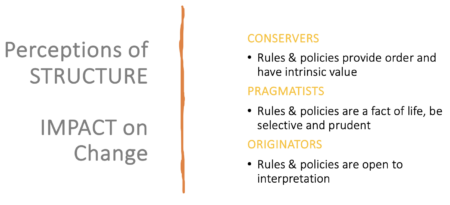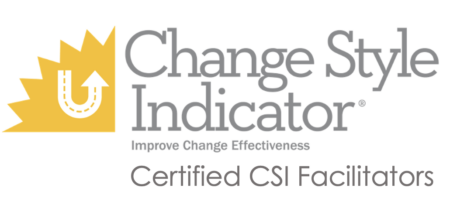Managing Change for Leaders
 Managing change in today’s workplace requires agility, emotional intelligence, and outstanding listening skills. Yet, many leaders haven’t mastered the skills needed to leverage team discussions and effectively drive critical problem-solving and decision making.
Managing change in today’s workplace requires agility, emotional intelligence, and outstanding listening skills. Yet, many leaders haven’t mastered the skills needed to leverage team discussions and effectively drive critical problem-solving and decision making.
Truly great leaders must get out or their own way and tap into team expertise. Understanding what’s important to different team members is critical to manage change efficiently and to achieve high performance.
Gaining insight into the three types of change style preferences provides a framework to navigate personal change preferences while increasing efficiencies and collaboration. The Change Style Indicator (CSI) is a powerful model for understanding change style preferences.
Let’s look at the three change styles on the CSI continuum. Then test your knowledge with the What’s My Change Style Challenge!

Conserver Change Style
The conserver is cautious and reflective preferring a predictable environment. Preservation of established traditions is valued. Conservers like to focus on details in a structured environment.
Pragmatist Change Style
The pragmatist focuses on collaboration across the team. They are keen listeners while facilitating both sides of a discussion. Change that is functional and produces visible results is valued.
Originator Change Style
Originators like to challenge existing structures. Risk and uncertainty are perfectly acceptable. They can appear unconventional and spontaneous.
Summary of Change Style Preferences
You can identify different change styles by observing how an individual responds to change. Do they approach change with hesitation and prefer measured change? Or do they challenge the existing structure and think way outside of the box. Or are they somewhere in between.

What’s My Change Style Challenge!
Listening is key to understanding where a team member is coming from when faced with change. The words they use, their pace, and adaptability can be observed to identify their change style preference. Let’s give it a try. Identify the change style for each of the four scenarios listed below.
What’s My Change Style #1:
Based on the benefits the team outlined as important, this alternative is a good compromise.
What’s My Change Style #2:
I understand the benefits of this proposal, but I’m not comfortable unless we have more specifics to ensure a seamless execution.
What’s My Change Style #3:
The industry is moving in this direction. We need to release the product to ensure we are first to market.
What’s My Change Style #4:
There is a slight risk but it’s clear option #2 is the best decision for the company.
Congratulations! Check the answers at the bottom and find out how you did. Practice when you are at work. Listen for trigger words that will help you identify a change style preference. Once you are comfortable identifying change styles, the next step is to adapt your language to build a bridge of collaboration.
Learn more about the Change Style Indicator
ANSWERS:
#1 – Pragmatist
#2 – Conserver
#3 – Originator
#4 – Conserver (slight/moderate)

